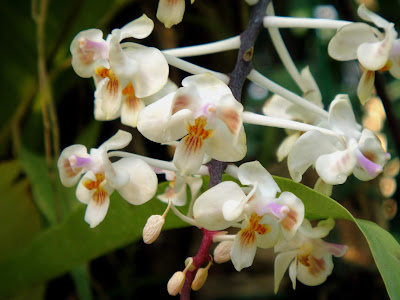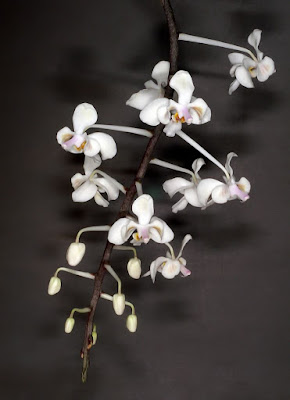The Celebes Phalaenopsis is native to The Island of Sulawesi (former Celebes) in Indonesia. The name of the species is given by the European name of this island. It is a miniature sized epiphyte with dark green, mottled with silver grey leaves. There are 3-5 leaves on the plant. The ovoid-oblong leaves are 15-18 cm long.
Phalaenopsis celebensis orchid, also called as The Celebes Phalaenopsis, is a species of the genus Phalaenopsis. There is no synonym of this species. This species has been completely described only by Sweet in 1980, 46 years after its discovery.
IDENTIFY PHALAENOPSIS CELEBENSIS ORCHID
The Celebes Phalaenopsis is native to The Island of Sulawesi (former Celebes) in Indonesia. The name of the species is given by the European name of this island.
It is a miniature sized epiphyte with dark green, mottled with silver grey leaves. There are 3-5 leaves on the plant. The ovoid-oblong leaves are 15-18 cm long.
Phalaenopsis celebensis orchid blooms in July and August on a lateral, arching then pendant, 16" (40 cm) long, purplish-green, racemose or paniculate, many flowered inflorescence with small bracts and successively opening flowers. The flowers are 2 cm in diameter and open several at a time, starting from the base of the inflorescence. They are spectacular, star-shaped, snow-white with bright orange or lilac spots on the lip. The inner whorls are slightly bent.
It is a kind of medium difficulty. We must guarantee the constant temperatures throughout the year and the right humidity. For the rest there are no other difficulties.
GROW AND CARE PHALAENOPSIS CELEBENSIS ORCHID
Cultural information should only be used as a guide, and should be to be adapted to suit you. Your physical location; where you grow your plants, how much time you have to devote to their care, and many other factors, will need to be taken into account. Only then can you decide on the cultural methods that best suit you and your plants.
Light:
Phalaenopsis celebensis orchid needs a light level of 10,000-12,000 lux. It should have year-round full shade, excessive light can cause reddening of the leaves.
Temperature:
The average temperature of the summer day is 30-32 ° C, night 22-23 ° C, giving a daily difference of 7-9 ° C. The average temperature of the winter day is 29-30 ° C, the night 22-23 ° C, giving a daily difference of 7-8 ° C. The daily difference is greater than the temperature changes associated with the seasons.
Humidity:
It is a quite demanding species with regard to the humidity of the air and suffers if kept at a level lower than 50-55%; we recommend a humidity level of 70-80%, which would be perfect for a harmonious development of the plant.
Substrate and growing media:
It can be placed both in pots and on support /raft. Mount it on the raft you need put layers of moss under the roots and a little 'above the roots (but without touching the base of the plant) to ensure a reserve of moisture. If it is grown in the pot, the substrate must be a mixture of 12-16 mm bark with moisture retaining additives or peat moss with perlite or charcoal added to improve breathability.
Watering:
Plants should be constantly moist. Hot water with a temperature of about 21 ° C is recommended for watering. Watering should be abundant for 6 months, after which the amount of water should be slightly reduced for the next 6 months. The best time to do the wetting is in the morning, so that the plants have the opportunity to dry well before the arrival of the evening. If the plant is mounted, it requires spraying 1-2 times a day, depending on the temperature (the faster the moss is dried under the roots and the more the orchid needs to be sprayed).
Fertilizer:
Phalaenopsis celebensis is fertilized throughout the year using a special orchid fertilizer (preferably liquid and well balanced: NPK in equal proportions) every 3 watering: you use 1/3 of the dose indicated on the bottle in the case of the vase and 1/8-1/10 of the dose if the orchid is mounted. Before fertilizing the plant it is necessary to water it: in this way there is no risk that the fertilizer will burn the young roots. To fertilize, immerse the pot or raft with the plant in a container with water and diluted fertilizer and leave it immersed for 15 min.
Rest period and repotting:
It has no rest period to stimulate flowering but in winter, if we keep the plants moist, then there is no need to increase the amount of water. If the cultivation temperatures are slightly lower, the excess water can cause root rot. In autumn, the level of light can be increased, and fertilization should be reduced during periods when there is no active growth.
Repotting is done every year, when the sphagnum has already lost most of the nutrients and risks accumulating toxic substances and excessive acidity. Plants are best repotted in spring when new roots begin to grow.

















COMMENTS